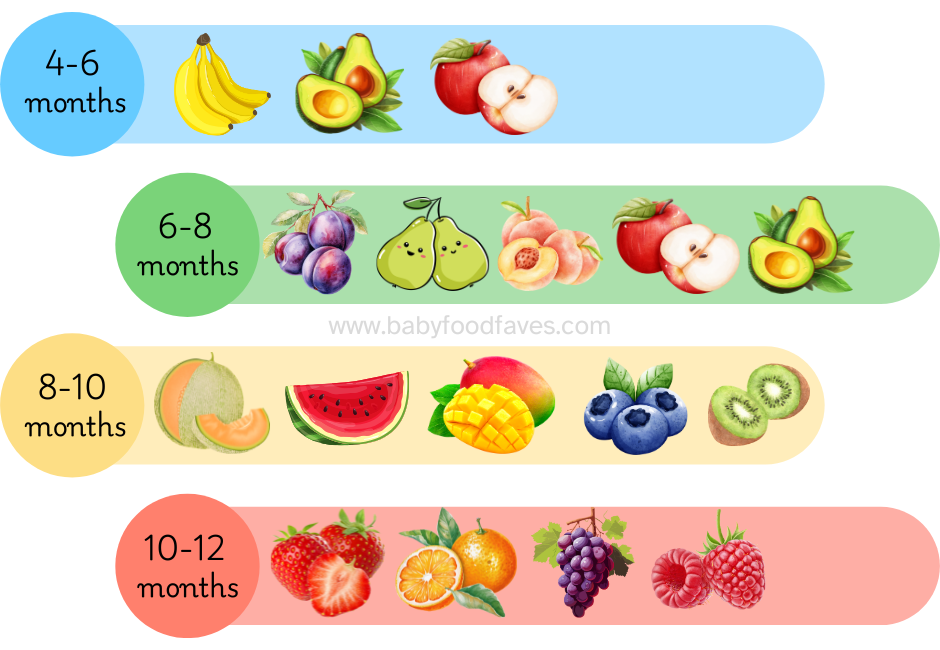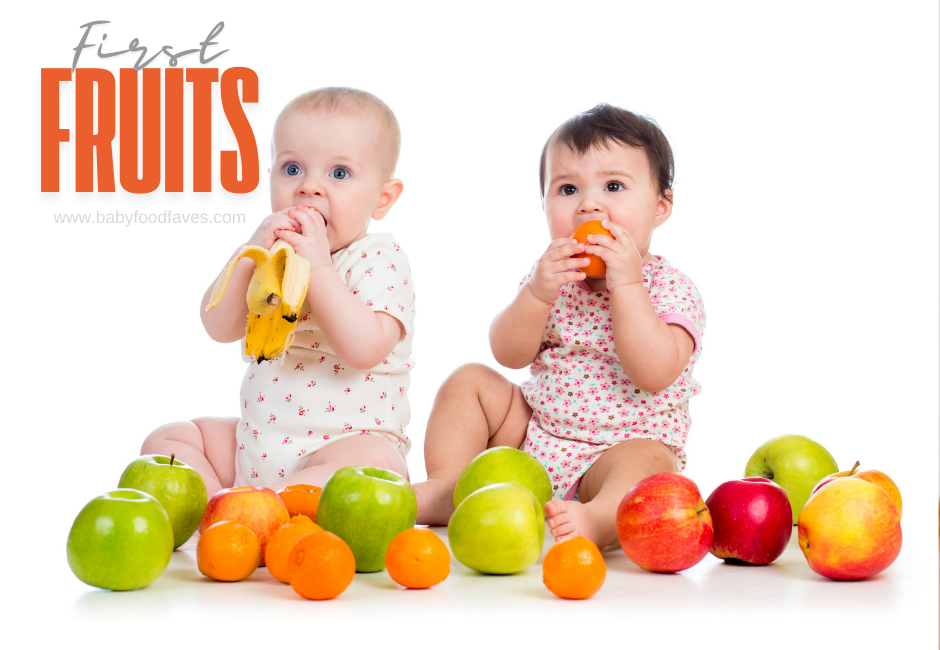When introducing your baby’s first fruits, timing plays a crucial role. I personally prefer starting with vegetables as the first solids and gradually adding fruits to the baby’s diet. Waiting to introduce fruits can help avoid issues like gas and bloating, as fruits may ferment in the stomach. This approach also ensures your baby’s digestive system can handle the new foods. If you want to begin with vegetables, check out my article about the best veggies to introduce to your toddler based on their age.
Table of Contents
Fruit as a First Solid: A Smart Start for Babies?
Many parents wonder when to introduce their baby’s first fruits and which ones are best. Remember, the timing and choice of fruits depend on your baby’s development. Your baby’s first fruits offer important vitamins and nutrients, but every child develops differently. Some parents choose to start with vegetables first to avoid digestive discomfort, while others prefer fruits for their sweeter taste. Regardless of your choice, introducing solid foods, including fruits, should happen gradually to allow your baby’s digestive system to adapt smoothly.
If you’re new to my blog, I have a detailed article about introducing solid foods for your baby, which includes more insights on when and how to introduce baby’s first foods.
Top 15 Baby’s First Fruits

Below is a list of great fruits for babies and toddlers, along with the ideal age to start introducing them into their diet. Please note that again these suggestions are just guidelines. You can introduce these fruits earlier or later based on your child’s readiness. You know your child best and can determine if they can digest certain foods.
- Bananas
Bananas often serve as one of the first fruits for babies due to their naturally soft texture, making them ideal for baby-led weaning.
When to Introduce: Introduce bananas between 4-6 months.
Benefits: Bananas are rich in potassium, vitamin B6, and fiber, supporting digestion and healthy growth.
Recipes:- Banana Puree: Mash a ripe banana until smooth and thin with breast milk or formula for younger babies.
- Banana Oatmeal: Mix mashed banana with cooked oatmeal for added flavor and texture.
- Banana Yogurt: Blend banana with plain yogurt for a creamy and nutritious snack.
- Apples
Apples are rich in vitamins, minerals, and fiber, making them an excellent choice for your baby’s first fruits.
When to Introduce: Introduce apples around 6-8 months.
Benefits: Apples are high in vitamin C and fiber, supporting immune health and digestion.
Recipes:- Applesauce: Steam and puree apples until smooth. Add cinnamon for flavor if desired.
- Baked Apple Slices: Bake thinly sliced apples until soft for a tasty finger food.
- Apple-Carrot Puree: Combine steamed apples with cooked carrots and blend until smooth.
- Avocado
Avocados, though technically a fruit, offer a creamy texture and are packed with healthy fats, making them an excellent choice for brain development and overall growth.
When to Introduce: Introduce avocado around 6 months.
Benefits: Avocado is rich in healthy fats, vitamins, and minerals, supporting brain development and overall growth.
Recipes:- Avocado Mash: Mash ripe avocado until smooth. Serve alone or mix with other pureed fruits.
- Avocado Banana Smoothie: Blend avocado with banana and a splash of breast milk or formula for a creamy treat.
- Avocado Toast: Spread mashed avocado on whole-grain toast for a nutritious finger food.
- Pears
Like apples, pears are gentle on the stomach and high in fiber, making them ideal for easing baby’s constipation.
When to Introduce: Introduce pears around 6-8 months.
Benefits: Pears are high in fiber and vitamin C, aiding digestion and supporting immune health.
Recipes:- Pear Puree: Steam or bake pears until soft, then puree until smooth.
- Pear Rice Cereal: Mix mashed pear with baby rice cereal for added flavor and nutrition.
- Pear Blueberry Mash: Combine mashed pear with mashed blueberries for a colorful, nutritious snack.
- Mangoes
Mangoes are naturally sweet and loaded with vitamins A and C, which support vision health and immune function.
When to Introduce: Introduce mangoes around 8-10 months.
Benefits: Mangoes are rich in vitamins A and C, supporting vision health and immune function.
Recipes:- Mango Yogurt: Blend ripe mango with plain yogurt for a creamy and nutritious snack.
- Mango Rice Pudding: Mix mashed mango with cooked rice and a dash of cinnamon for a delicious dessert.
- Mango Banana Smoothie: Blend mango with banana and a splash of coconut milk for a tropical treat.
- Blueberries
Rich in antioxidants and vitamin C, blueberries support brain development and immune health. Serve them mashed or pureed for babies, making them an excellent choice for first fruits.
When to Introduce: Introduce blueberries around 8-10 months.
Benefits: Blueberries are packed with antioxidants and vitamin C, supporting brain development and immune health.
Recipes:- Blueberry Puree: Steam or mash fresh blueberries until soft, then puree until smooth.
- Blueberry Banana Pancakes: Mix mashed blueberries with mashed banana into pancake batter for a naturally sweet twist.
- Blueberry Chia Pudding: Blend blueberries with coconut milk and chia seeds for a nutritious, delicious pudding.
- Peaches
Soft and juicy, peaches are rich in vitamin C and vitamin A, essential for skin health and immune support.
When to Introduce: Introduce peaches around 6-8 months.
Benefits: Peaches are high in vitamin C and vitamin A, supporting skin health and immune function.
Recipes:- Peach Puree: Steam or bake peaches until soft, then puree until smooth.
- Peach Oatmeal: Mix mashed peach with cooked oatmeal for added sweetness and nutrition.
- Peach Banana Sorbet: Blend frozen peaches with bananas for a refreshing, healthy dessert.
- Plums
Plums are high in fiber, aiding digestion and preventing constipation. They can be steamed and pureed or served as small, soft pieces for older babies.
When to Introduce: Plums can be introduced at 6-8 months, offering a tangy and nutritious fruit option.
Benefits: Plums are high in fiber, aiding digestion and preventing constipation in babies.
Recipes:- Plum Compote: Simmer chopped plums with a splash of water until soft. Serve as a topping for yogurt or oatmeal.
- Plum Puree: Steam or bake plums until soft, then puree until smooth.
- Plum Banana Mash: Combine mashed plum with mashed banana for a sweet and nutritious snack.
- Kiwi
Kiwis are packed with vitamin C, vitamin K, and fiber. Remove the fuzzy skin and puree or mash the flesh for baby-friendly consumption.
When to Introduce: Kiwis can be introduced at around 8-10 months, offering a unique flavor and texture.
Benefits: Kiwi is rich in vitamin C, vitamin K, and fiber, supporting immune health and digestion.
Recipes:- Kiwi Puree: Peel and mash ripe kiwi until smooth. Serve alone or mixed with other pureed fruits.
- Kiwi Strawberry Salad: Dice kiwi and strawberries and toss with a squeeze of lemon juice for a refreshing snack.
- Kiwi Banana Smoothie Bowl: Blend kiwi with banana and spinach for a nutrient-packed breakfast option.
- Strawberries
Bursting with vibrant flavor, strawberries offer a sensory adventure for your baby’s palate, introducing them to new tastes and textures.
When to Introduce: Strawberries can be introduced around 10-12 months, as they may be allergenic for some babies.
Benefits: Strawberries are rich in vitamin C, manganese, and antioxidants, supporting immune health and fighting inflammation.
Recipes:- Strawberry Banana Puree: Blend ripe strawberries with banana for a sweet and nutritious puree.
- Strawberry Yogurt Bites: Mix mashed strawberries with plain yogurt and freeze in small portions for a refreshing teething snack.
- Strawberry Spinach Salad: Toss chopped strawberries with baby spinach and a drizzle of balsamic vinaigrette for a tasty side dish.
- Grapes
Juicy and refreshing, grapes are a hydrating snack packed with vitamins and minerals to support your baby’s growth.
When to Introduce: Grapes can be introduced around 10-12 months, but it’s essential to cut them into small, manageable pieces to prevent choking.
Benefits: Grapes are high in water content and antioxidants, supporting hydration and overall health.
Recipes:- Grape Puree: Blend ripe grapes until smooth, adding a splash of water if needed.
- Grape and Cheese Kabobs: Skewer halved grapes and cubes of cheese for a fun and nutritious snack.
- Grape and Apple Salad: For a refreshing fruit salad, combine sliced grapes with diced apples and a squeeze of lemon juice.
- Raspberries:
Tart and flavorful, raspberries are loaded with fiber and antioxidants, promoting healthy digestion and immune function.
When to Introduce: Raspberries are a tart and flavorful option that can be introduced at around 10-12 months.
Benefits: Raspberries are high in fiber, vitamin C, and antioxidants, supporting digestive health and immune function.
Recipes:- Raspberry Smoothie: Blend ripe raspberries with banana and Greek yogurt for a creamy and nutritious smoothie.
- Raspberry Oatmeal Bars: Mix mashed raspberries with cooked oats and bake into bars for a tasty finger food.
- Raspberry Chia Jam: Mash raspberries and mix with chia seeds and a touch of honey for a homemade jam spread.
- Watermelon
Refreshing and hydrating, watermelon is a summertime favorite that provides vitamins A and C for your baby’s overall health.
When to Introduce: Watermelon can be introduced around 8-10 months, offering a hydrating and refreshing fruit option.
Benefits: Watermelon is high in water content and vitamins A and C, supporting hydration and immune health.
Recipes:- Watermelon Popsicles: Blend ripe watermelon and pour into popsicle molds for a refreshing summer treat.
- Watermelon Salad: Toss cubed watermelon with feta cheese, mint, and a drizzle of balsamic glaze for a flavorful salad.
- Watermelon Smoothie Bowl: Blend watermelon with frozen banana and coconut water for a hydrating and nutrient-packed breakfast option.
- Oranges
Tangy and citrusy, oranges are bursting with vitamin C and antioxidants to boost your baby’s immune system.
When to Introduce: Oranges can be introduced around 10-12 months, offering a tangy and citrusy flavor.
Benefits: Oranges are high in vitamin C and antioxidants, supporting immune health and collagen production.
Recipes:- Orange Puree: Blend peeled and seeded oranges until smooth, adding water if needed.
- Orange Banana Pancakes: Mix mashed oranges with mashed banana into pancake batter for a citrusy twist.
- Orange Chicken: Use freshly squeezed orange juice as a marinade for chicken for a sweet and savory dish.
- Cantaloupe
Sweet and succulent, cantaloupe offers a tropical twist to your baby’s palate, introducing them to the exotic flavors of ripe fruit.
When to Introduce: Cantaloupe can be introduced around 8-10 months, offering a sweet and juicy fruit option.
Benefits: Cantaloupe is high in vitamin A, vitamin C, and antioxidants, supporting eye health and immune function.
Recipes:- Cantaloupe Smoothie: Blend ripe cantaloupe with Greek yogurt and a splash of orange juice for a creamy and refreshing smoothie.
- Cantaloupe Salsa: Dice cantaloupe and mix with chopped cilantro, red onion, and lime juice for a flavorful salsa.
- Cantaloupe Sorbet: Blend frozen cantaloupe chunks with a touch of honey for a naturally sweet and refreshing dessert.
Practical Parent Tips for Successfully Introducing First Fruits to Your Baby
- Start Simple: Begin with small amounts and gradually increase as your baby gets used to the new flavors and textures.
- Choose Ripe Fruits: Opt for ripe fruits that are soft and easy to mash, making them easier for babies to eat and digest.
- Allergies: Always introduce new fruits one at a time to monitor for any potential allergic reactions. Consult your pediatrician if you have any concerns.
- Gradually Increase Texture: As your baby becomes more accustomed to purees, gradually introduce mashed or finely chopped fruits to encourage oral motor development.
- Offer Variety: Rotate between different fruits to expose your baby to various flavors, textures, and nutrients, keeping mealtime engaging and nutritious.
- Be Patient: It’s normal for babies to reject new foods initially, so be patient and continue offering fruits in different forms until they become more accepting.
- Encourage Self-Feeding: Introduce finger foods like small fruit slices or pieces to encourage self-feeding and develop your baby’s fine motor skills.
- Stay Positive: Create a positive mealtime environment by offering fruits with enthusiasm and praise, fostering a lifelong love for healthy eating habits in your baby.
10 Tips for Getting Toddler to Eat Fruits
- Lead by Example: Show your toddler how much you enjoy fruits by eating them yourself during meals and snacks. Kids often copy what their parents do, so if they see you eating fruits, they’ll be more likely to want them, too.
- Make Fruits Fun: Serve fruits in fun ways, like cutting them into shapes, making fruit sticks, or arranging them in cool patterns on the plate. Making fruits look exciting can make them more appealing to toddlers.
- Give Them Something to Dip Fruits In: Offer fruits with dips like yogurt, nut butter, or homemade fruit salsa. Dipping fruits can make them more fun to eat and adds extra flavor.
- Offer Lots of Different Fruits: Give your toddler a variety of fruits to try. This helps them experience different tastes, textures, and colors. Switching up the fruits regularly keeps mealtime fun and interesting.
- Make Mealtimes Positive: Create a calm and happy atmosphere during meals with no distractions. Encourage your toddler to focus on enjoying the taste of the fruits.
- Let Them Help with Cooking: Get your toddler involved in preparing meals by letting them wash, peel, or chop fruits (with your help). This makes them feel more excited about eating the fruits they helped prepare.
- Praise Them for Trying New Fruits: When your toddler tries a new fruit or eats it without fuss, give them lots of praise and maybe a little reward. This helps them learn to enjoy eating fruits.
- Be Patient: Your toddler might not like a new fruit at first, and that’s okay. Keep offering it to them in different ways and be patient. Don’t force them to eat it.
- Mix Fruits into Other Foods: Blend fruits into smoothies, yogurt, or oatmeal to make them more tasty and healthy. You can mix fruits with milk or yogurt to make yummy smoothie bowls or ice lollies.
- Make Fruit Snacks Accessible: Keep a bowl of washed and cut fruits within easy reach for your toddler to grab whenever they feel hungry. Having fruits readily available makes it more likely that they’ll choose them as snacks.
FAQ – Common Concerns and Questions About Baby’s First Fruits
Q: When should I start introducing baby’s first fruits?
- A: The general recommendation is to start offering baby’s first fruits around 4 to 6 months of age, when your baby begins to show signs of readiness for solid foods.
Q: Can I give my toddler fruit juice instead of whole fruits?
- A: It’s generally best to offer whole fruits rather than fruit juice, as whole fruits contain more fiber and fewer sugars. If you do offer juice, dilute it with water and limit it to small amounts, as excessive juice consumption can contribute to tooth decay and excess calorie intake.
Q: Are there any fruits I should avoid giving to my toddler?
- A: While most fruits are safe for toddlers, it’s essential to avoid giving them whole grapes, as they pose a choking hazard. Additionally, be cautious with small fruits like berries, ensuring they are cut into manageable pieces to prevent choking.
Q: How can I ensure my toddler gets a variety of fruits in their diet?
- A: You can incorporate fruits into various meals and snacks, such as smoothies, yogurt parfaits, fruit salads, or as toppings for oatmeal or pancakes.
Q: Can toddlers have dried fruits as snacks?
- A: Dried fruits can be a convenient snack option for toddlers, but they are often higher in sugar and lower in water content compared to fresh fruits. Offer dried fruits in moderation and choose varieties without added sugars or preservatives.
Q: Can I mix baby’s first fruits with vegetables?
- A: Yes, blending fruits with vegetables is a great way to balance flavors. It can make your baby more receptive to new tastes while still providing the health benefits of baby’s first fruits.
Q: Are frozen fruits as nutritious as fresh fruits for toddlers?
- A: Frozen fruits can be just as nutritious as fresh fruits, as they are typically frozen at peak ripeness, locking in nutrients. Look for unsweetened frozen fruit options and use them in smoothies, yogurt parfaits, or homemade fruit popsicles for a convenient and nutritious treat.
I’d really like to know what fruits your kids enjoy and how they like to eat them. Feel free to leave a comment below so other parents can get some ideas too!





